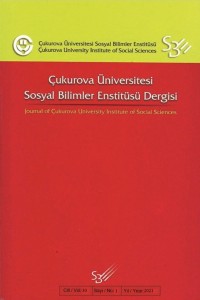Öz
Bu çalışma, Türkiye'de 1980-2018 döneminde ticari açıklık ile enflasyon arasındaki ilişkiyi incelemeyi amaçlamaktadır. Bu kapsamda, yıllık frekansta veriler kullanılarak, Johansen Eşbütünleşme Test ve Tam Modifiye Edilmiş Sıradan En Küçük Kareler tahmin yöntemleri uygulanmıştır. Johansen Eşbütünleşme test yöntemi sonuçları, ticari açıklık, enflasyon oranı ve diğer değişkenlerin uzun dönemde ilişkili olduklarını göstermektedir. Tam Modifiye Edilmiş En Küçük Kareler tahmin sonuçları, ticari açıklığın, dış ticaret hadlerinin ve reel GSYİH büyüme oranının enflasyon üzerinde negatif yönde etkili olduğunu göstermektedir. Bulgular, Türkiye'de ticari açıklığın enflasyon üzerinde etkili olduğunu ve Romer Hipotezinin Türkiye için geçerli olduğu varsayımını desteklemektedir.
Anahtar Kelimeler
Kaynakça
- Aron, J. & Muellbauer, J. (2007). Inflation dynamics and trade openness: with an application to South Africa. CSAE Working Paper Series no.11.
- Ashra, S. (2002). Inflation and openness: a study of selected developing economies. Working Paper No. (84), Indian Council for Research on International Economic Relations, New Delhi, India.
- Atabay, R. (2016). The relationship between trade openness and inflation in Turkey. International Journal of Research in Business & Social Science, 5(3), 137-145.
- Binici, M., Cheung, Y. W. & Lai, K. S. (2012). Trade openness, market competition, and countries: Some sectoral evidence from OECD countries. Türkiye Cumhuriyet Merkez Bankası Working Paper No: 12/06, 1-19.
- Bowdler, C. & Nunziata, L. (2006). Trade openness and inflation episodes in the OECD. Journal of Money, Credit, and Banking, 38(2): 553-563.
- Chhabra, M. & Alam, Q. (2020). An empirical study of trade openness and inflation in India. DECISION: Official Journal of the Indian Institute of Management Calcutta, Springer; Indian Institute of Management Calcutta, 47(1): 79-90.
- Fujii, E. (2017). What does trade openness measure?. Ceifo Working Papers 6656.
- Güneş, Ş. & Konur, F. (2013). Türkiye ekonomisinde dışa açıklık ve enflasyon ilişkisi üzerine ampirik bir analiz. Eskişehir Osmangazi Üniversitesi İİBF Dergisi, 8(2): 7-20.
- Johansen, S. (1988). Statistical analysis of cointegrating vectors. Journal of Economic Dynamics and Control, 12: 231-254.
- Johansen, S. (1991). Estimation and hypothesis testing of cointegration vectors in Gaussian vector autoregressive models. Econometrica, 59: 1551-1580.
- Kızılgöl, Ö. A. & İpek, E. (2015). Türkiye’de enflasyon ile ticaret açıklığı arasındaki ilişki. Anadolu Üniversitesi Sosyal Bilimler Dergisi, 15(4): 43-54.
- Kurihara, Y. (2013). International trade openness and inflation in Asia. Research in World Economy, 4 (1): 70-75.
- Lee, J. & Strazicich, M. C. (2003). Minimum lagrange multiplier unit root test with two structural breaks. The Review of Economics and Statistics, 85(4): 1082-1089.
- Lin, F., Mei, D., Wang, H., & Yao, X. (2017). Romer was right on openness and inflation: evidence from sub-saharan Africa. Journal of Applied Economics, 20(1): 121–140.
- Lotfalipour, M. R., Montazeri, S. & Sedighi, S. (2013). Trade openness and inflation: Evidence from MENA region countries. Economic Insights – Trends and Challenges, 2(115): 1-11.
- Mukhtar, T., Jehan, Z. & Bilquees, F. (2019). Is trade openness inflationary in developing economies: An asymmetric analysis for Pakistan. Pakistan Economic and Social Review, 57(1): 47-68.
- Munir, S., Hasan, H. & Muhammad, M. (2015). The effect of trade openness on inflation: Panel data estimates from selected Asian economies (1976-2010). Southeast Asian Journal of Economics, 3(2): 23-42.
- Munir, S. & Kiani, A. K. (2011). Relationship between trade openness and inflation: Empirical evidences from Pakistan (1976–2010). The Pakistan Development Review, Pakistan Institute of Development Economics, 50(4): 853-876.
- Özçağ, M. & Bölükbaş, M. (2018). Ticari dışa açıklık ve enflasyon ilişkisi: Romer hipotezi çerçevesinde Türkiye için bir analiz. Maliye Dergisi, 174: 112-130.
- Rangkakulnuwat, P. & Thurner, P. (2017). Trade openness and inflation: An empirical evidence of Thailand. Proceedings of 76th IRES International Conference, Osaka, Japan, 8th-9th August 2017.
- Romer D. (1993). Openness and inflation: Theory and evidence. Quarterly Journal of Economics, 108(4):869-903.
- Sachsida, A. & Mendonça, M. J. C. (2015). Inflation and trade openness revised: An analysis using panel data. Discussion Papers 1148, Instituto de Pesquisa Econômica Aplicada - IPEA.
- Sahu, P. & Sharma, N. K. (2018). Impact of trade openness on ınflation in India: An autoregressive distributed lag (ARDL) approach. The Empirical Economics Letters, 17(1).
- Sakanko, M., & Joseph, D. (2019). Trade openness and inflation: Empirical explanation of the nexus in Nigeria. International Journal of Social Sciences and Economic Review, 1(2): 35-45. https://doi.org/10.36923/ijsser.v1i2.33
- Sepehrivand, A. & Azizi, J. (2016). The effect of trade openness on inflation in D-8 member countries with an emphasis on Romer theory. Asian Journal of Economic Modelling, 4(4): 162-167.
- Şimşek, D. & Hepaktan, E. (2019). Ticari açıklık, istihdam ve enflasyon ilişkisi. Celal Bayar Üniversitesi Sosyal Bilimler Dergisi, 17(4): 316-336.
- The World Bank (2020). [Çevrim-içi: Data Bank https://data.worldbank.org/], Erişim tarihi: 15.04.2020
- Zakaria, M. (2010). Openness and inflation: Evidence from time series data. Doğuş Üniversitesi Dergisi, 11(2): 313-322.
Ayrıntılar
| Birincil Dil | Türkçe |
|---|---|
| Bölüm | Makaleler |
| Yazarlar | |
| Yayımlanma Tarihi | 30 Nisan 2021 |
| Gönderilme Tarihi | 28 Haziran 2020 |
| Yayımlandığı Sayı | Yıl 2021 Cilt: 30 Sayı: 1 |


